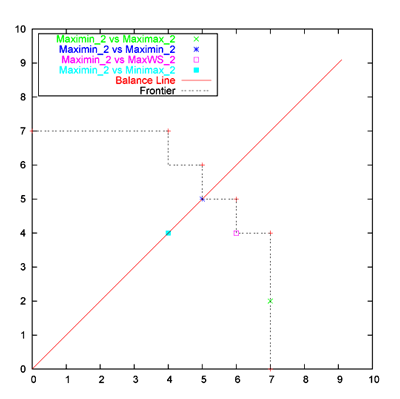|
|||
Adversarial Constraint Satisfaction by Game Tree Searchby James Little and Ken Brown How players taking part in specially configured games can solve real-world optimisation problems. Many decision problems can be modelled as adversarial constraint satisfaction (CS), which allows us to integrate methods from AI game playing into traditional CS backtracking search. In particular, by using the idea of opponents, we can model both collaborative problem solving, where intelligent participants with different agendas must work together to solve a problem, and multi-criteria optimisation, where one decision maker must balance different objectives. To date in our research we have focused on the case where two opponents take turns to instantiate constrained variables, each trying to direct the solution towards their own objective. We represent the process as game-tree search and as a consequence, we develop variable and value ordering heuristics based on game playing strategies. We have evaluated the performance of these algorithms on general-sum graph colouring games, for both multi-participant and multi-criteria optimisation. As a motivating example, consider planning university committee meetings. Each committee has possible meeting times, and each room on campus has limited availability. Researchers want to cluster meetings together, to leave more time for research. Administrators want to minimise travel time, preferring to locate the meetings close to the administration block. How should the University produce a schedule? The approach considered in this paper would appoint two agents, one for each interest group, and have them take turns choosing rooms and times for individual meetings, in the hope that the interplay between their choices would produce a fair settlement. The agents would clearly bring their own objectives to the problem. If the university prefers a particular balance, it could appoint agents with appropriate negotiating skills. Our research ultimately has two main objectives: (i) to provide assistance for self-motivated decision makers in possibly adversarial situations, and (ii) to provide a convenient framework for modelling and solving multi-criteria constrained optimisation problems. Within the context of one particular game scenario, for (i) we propose configurations of the constraint-based searcher for play against known opponents. For (ii) we show how to configure both players to achieve desired results. What is the Game A position in the game corresponds to some of the variables assigned values consistent with the constraints. As a game, we could expect it to terminate without necessarily assigning all variables with values and still be able to calculate a payoff for each player. Therefore we need to modify the game to include backtracking and allow players to collaborate in allowing another move to be chosen. At a terminal position, each player calculates their payoff indicating how well they have satisfied their objectives. How the player plays the game has a bearing on these eventual payoffs. A variety of strategies have been investigated for the players to use, based on the well-known Minimax algorithm. Experiments & Results
The figure shows the results of one game with a variety of different playing strategies. The results are measured with respect to the Pareto frontier and a balance line, indicating how well each objective does relative to the other. The experiments are run on 50 different graph colouring games all of 16 nodes and the results are averaged across them. About the Research Please contact: |
|||



